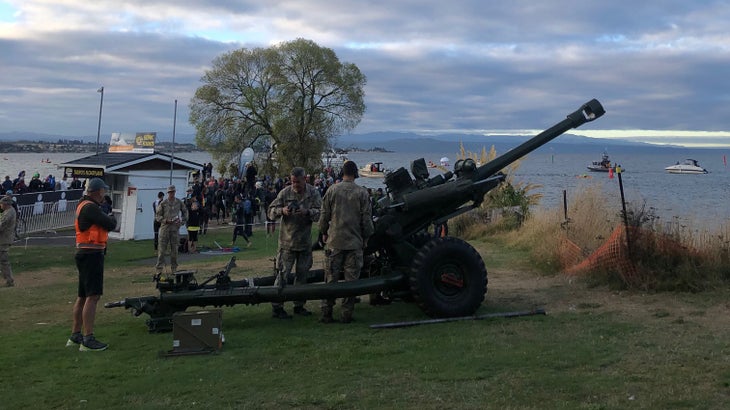New perk! Get after it with local recommendations just for you. Discover nearby events, routes out your door, and hidden gems when you sign up for the Local Running Drop.
The loudest noise on race day comes from the smallest package–specifically, one that measures 12 inches long, 6 inches wide, and 7 inches tall. Because it’s so tiny, most people don’t see it, but they know it’s there. Spectators cover their ears, and athletes tense up in anticipation, ready to lurch forward at the sound of the Ironman start cannon.
Most races today use an air horn or traditional starter’s pistol (which shoots blanks into the air). Ironman, though, loves a good spectacle and the cannon adds a certain ceremonial flair to its races. But it hasn’t always been that way–in fact, the Ironman World Championship used to kick off every year to the noise of a pipe bomb.
Through 1998 at the Ironman World Championship, the race timer used a homemade cannon, a somewhat crude device resembling a controlled pipe bomb. The device did its job–the noise was heard loud and clear by athletes and spectators on the Big Island–but there were obvious safety concerns. The homemade cannon also lacked the flair and ceremony race directors felt the event deserved. In 1999, when a new race timer was hired, Ironman World Championship volunteer security director Steven Foth took it upon himself to find a new way to start the race. His diligence led to the creation of the iconic cannon now fired at the start of the Ironman World Championship every year. The device, which was milled and machined in Hilo, Hawaii, is still in use today. When it’s not being used for the race, it is stored and maintained by Ken Silva, a personal friend of Foth.
Kona isn’t the only Ironman event that brings out a cannon for a memorable start to race day. Most events in North America use a Winchester cannon to signal the start. Some have created an even bigger impression (and bigger noise) than the Hawaii version. The first few years of Ironman Lake Placid were kicked off with a large, six-foot cannon, while at Ironman Mont-Tremblant a full-scale black powder cannon was used. At the original Ironman California (the predecessor to Ironman 70.3 Oceanside), the race was started with a howitzer on Marine Corps Base Camp Pendleton.

In Oceania, a cannon has been used to start Ironman New Zealand since the event moved to Taupo in 1999. The original cannon, which was transported from Auckland for the race, has been replaced by a howitzer in recent years, which is organized through the New Zealand Defense Force and delivered to Taupo. The start cannon fires at the conclusion of a haka, the ancient Maori dance that has evolved from a pre-battle intimidation tactic to a symbol of competition, hospitality and respect.
The honor of firing a start cannon is often given to a local dignitary or important tri figure. At the Ironman World Championship, this is typically a Hall of Fame inductee. After they fire the cannon, artillery specialists retrieve the spent shell (carefully, as it is hot), then mark it with the event and date to provide to the dignitary as a keepsake.
In some areas where noise ordinances or cannon discharges are outlawed, an air horn is used to start the race. Air horns are also the go-to backup for every race with a cannon–though misfires and duds occur rarely, they do happen. That’s why behind every start cannon, you’ll see an Ironman staff member with an air horn extended skyward, just in case.
If you’re racing in Kona and want to experience the start cannon without the race-morning jitters, head to the start line at 8 p.m. the Friday before the race. Testing the Ironman World Championship cannon has become a ritual for Foth, Silva, and swim director Jan War, who do a test fire to confirm the exact placement of the cannon. If you look down the shore to the tent where finish line volunteers are doing their pre-race briefing, you’ll see them file out–for volunteers, this cannon signals not the start of a race, but the end of their meeting.
